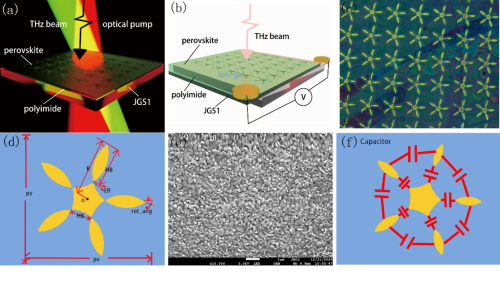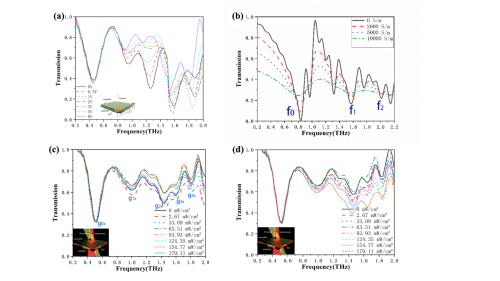Researchers from the precision optical manufacturing and testing center of Shanghai Institute of Optics and mechanics (SIOM) of the Chinese Academy of Sciences (CAS), Shandong Zaozhuang University, and Tianjin University, realize the dual control of multi band Fano resonance on the integrated terahertz hypersurface of metal halide perovskite. The relevant results were published on Nanoscaleon on April 2, 2022.
Fano resonance is a special physical phenomenon, which has asymmetric linear distribution and sharp spectral characteristics, so it has a high Q quality factor. Multi band hypersurface optical devices based on Fano resonance are of great value for device design in the fields of communication and biology, such as time division multiplexing, terahertz high-speed wireless communication, biomedical sensors, optical decoders, and other device design fields.
Given the unique advantages of perovskite group materials with higher carrier mobility and longer diffusion length, the super surface based on perovskite has great research value, and it has great application potential in the fields of solar cells, LEDs, photodetectors, and lasers. However, there are relatively few reports of researchers using multi band Fano resonance to realize perovskite tunable metamaterial devices, and it is mainly based on optical modulation. Due to the structural limitation of the super surface micro nano unit, it can often only achieve fewer working bands (< =3), and it has a low Q quality factor, so the tuning function is weak, which affects its working performance.
In addition, the tuning range of the super surface element realized by optical tuning is very small. Therefore, the design and preparation of multi band Fano resonant perovskite Hypersurfaces with various modulation modes is a hot topic of interest to researchers at present.
To solve these problems, the research team designed and manufactured a tunable perovskite hypersurface based on the periodic structure of Pentagon petal shape, which can realize Fano resonance in five wave bands in the X direction, and many resonance bands have high Q quality factors. At the same time, because it is relatively difficult to build systems and use tunable optoelectronic materials, it is also very difficult to realize electromagnetic regulation by using electricity and light respectively. Using the unique photoelectric characteristics of perovskite films, researchers changed the conductivity of perovskite films on the super surface by adding a perovskite layer and an ionic glue film on the super surface, and then changed the conductivity of perovskite films on the super surface by means of laser and voltage changes. They realized the metamaterial integrated perovskite devices were independently modulated by laser and electronic equipment, and expanded the modulation mode of perovskite materials, with the maximum modulation depth (MD) of 197.39%.
In the experiment, researchers found that the capacitance effect between micro and nano units and the perovskite Fermi level regulation effect plays an important role in photoelectric modulation, especially since the modulation characteristics of electrical regulation have a wider frequency shift range and a larger amplitude tunable range.
This experiment realizes the dual control of multi band Fano resonance on the integrated terahertz hypersurface of metal halide perovskite, has important guiding significance for the future realization of multiple ways to modulate the electromagnetic characteristics of hypersurfaces and provides a new way for the future development of multiple ways of tunable hypersurfaces.

Fig.1. Schematics of multi-band Fano resonances with a metal-halide perovskite-integrated terahertz metasurface. (Image by SIOM)

Fig.2. (a) The measured transmission spectra of the metasurface under the electric modulation (b) The simulated transmission spectra of the metasurface with different conductivites (c) The measured transmission spectra of the metasurface under the optical modulation with the varying pump from 0-179.11mW/cm2 (d) The measured transmission spectra of the metasurface under the optical modulation with the varying pump from 0-33.09mW/cm2. (Image by SIOM)
Article website:
https://doi.org/10.1039/d2nr00292b
Contact:
WU Xiufeng
General Administrative Office
Shanghai Institute of Optics and Fine Mechanics, CAS
Email: xfwu@siom.ac.cn
Web: http://english.siom.cas.cn/